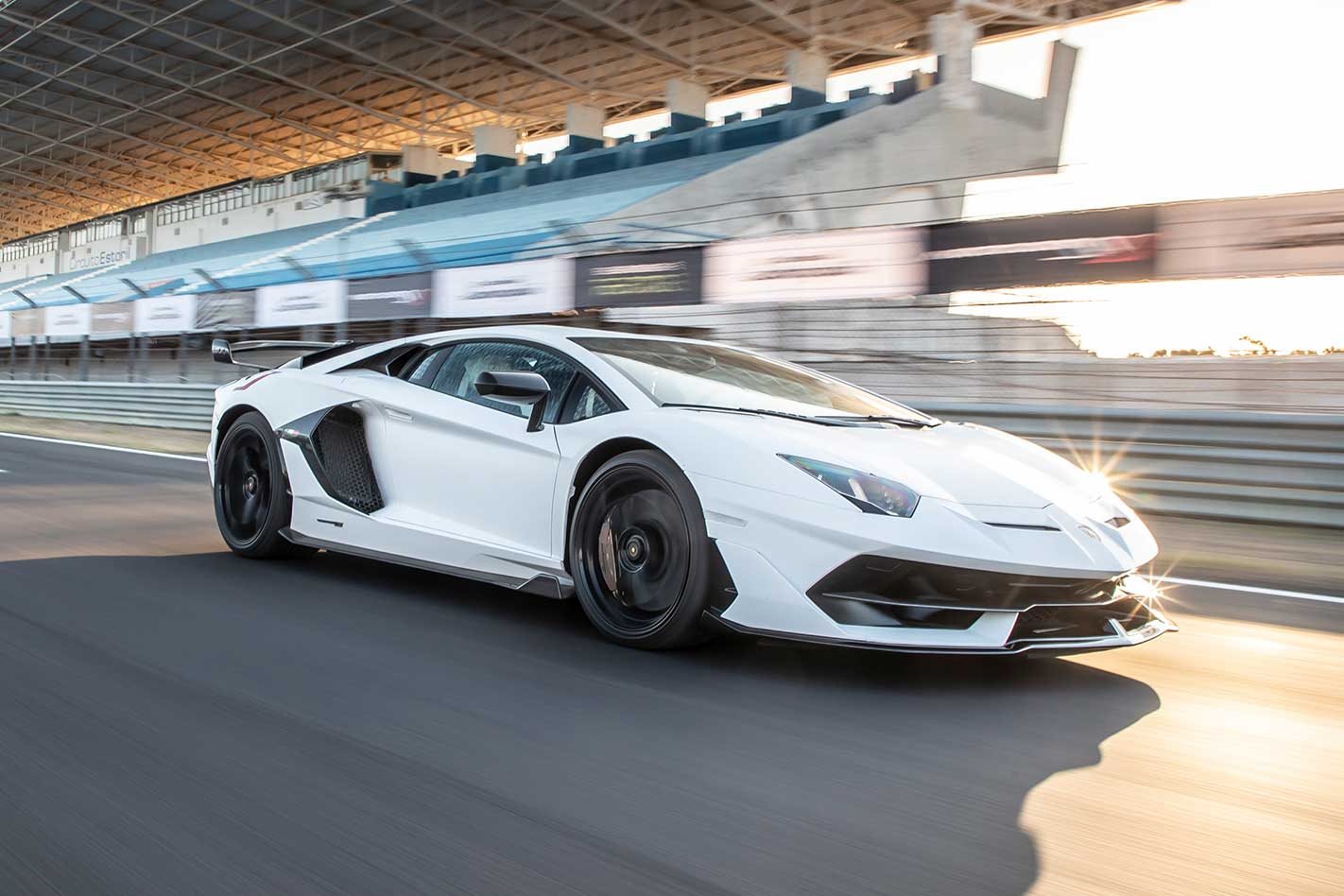AS I WRITE, I’m struggling with the idea that this is, for all we know, the last truly untampered Lamborghini V12. It’s one that’s liberated by atmospheric pressure alone, sans forced induction and/or the tech trickery of hybridisation and heavy batteries that are lambasting the classic supercar genre.
Yes, the future is no doubt faster for such crazy creations, but the theatre won’t transcend anywhere near as much. The Aventador SVJ makes me acutely aware of this and the fact it could very well be the last of a dying atmo V12 breed. Of course we don’t know this for sure, but it seems the stay of execution is almost over.

Making my point all too real is the fact that a number of Lamborghini Aventador SVJs are belting down the main straight at Estoril racetrack (a 4.182km circuit that was home to the Portuguese Grand Prix from 1984 to 1996) mere metres away from me. The noise is hard to put into words. It’s simply otherworldly and much more race meeting than track day.
That’s rare in the world of production cars, to the extent that there’s a ‘last of the interceptors’ feel about the Aventador, with its big, mid-mounted naturally aspirated V12 and all of the promise and compromise such an engine brings.
Sure, Ferrari still makes a naturally aspirated V12 (used in the sublime 812 Superfast), as will Aston Martin for a short while, but neither in quite the same setting as the manic Lambo. There’s a difference between a super-GT car and this, a super-sports car. A supercar of the original sense, partly figuratively, but also literally.
An Aventador’s mid-mounted engine breathes through a much shorter exhaust than a front-engined GT, so its bark is louder. It’s a fact that means a car like this will never be ‘so what’. It dominates the experience.
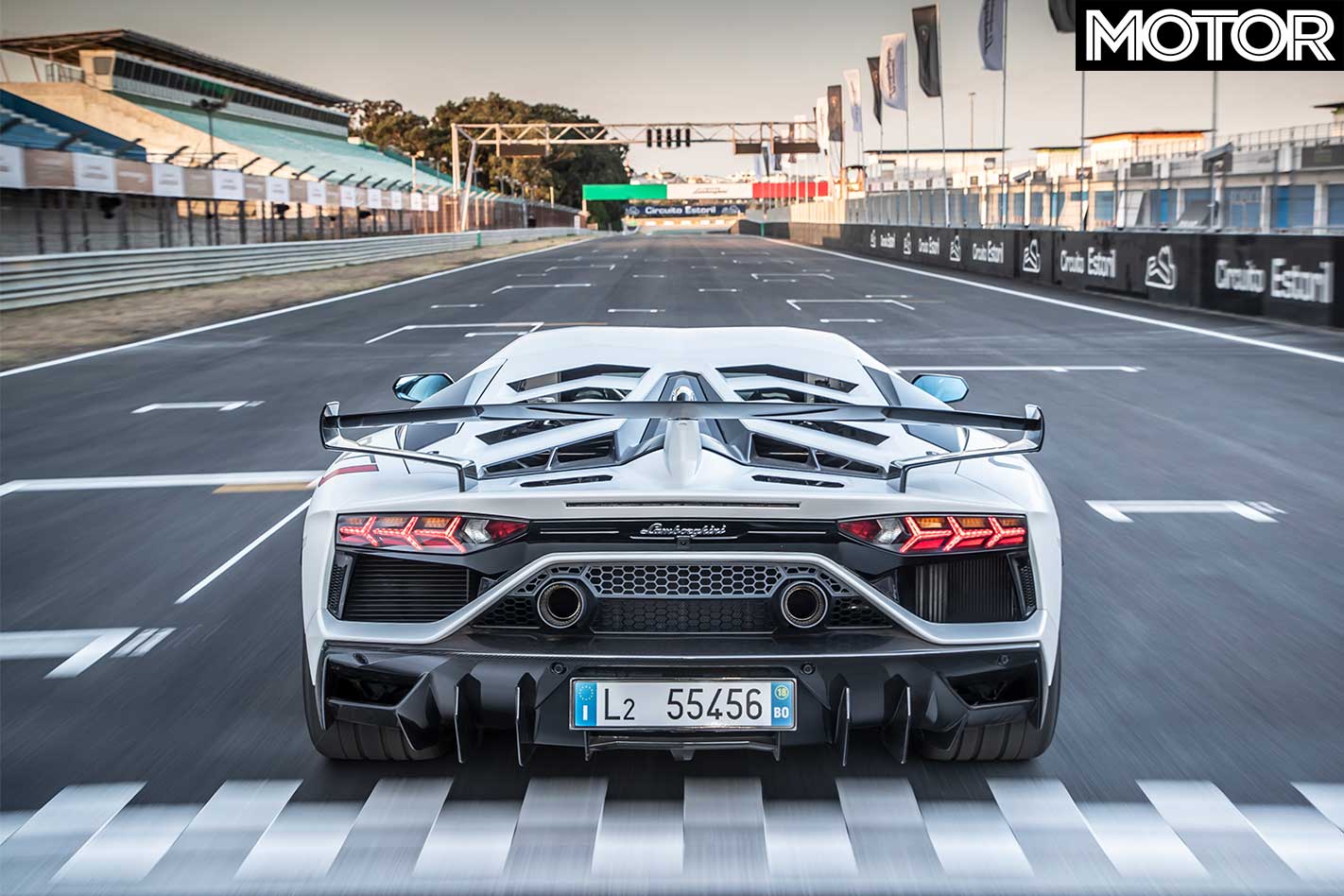
It’s important to remember that, whatever else you think about modern Lamborghinis and the way they’re used. Only five per cent of Aventador buyers will regularly show their car a racetrack. Which is a crying shame, because if owners did, they’d really feel how fast it is, rather than just know it set a 6min 44.97sec lap of the… well, you know where, the famed track somewhere in Europe’s heartland.
It achieves this feat by being more powerful, lighter, more aerodynamically clever, dynamically tweaked and having more grippy tyres than before. The full engineering gamut at Lamborghini’s disposal has been thrown at the Aventador. The J, standing for Jota (see page 52), isn’t just there for show.
Let’s start with the engine. The 6.5-litre V12 has titanium inlet valves, a lighter flywheel, less internal friction, an 8700rpm limiter and now makes an astonishing 566kW at 8500rpm. More importantly, though, the 690Nm peak torque was at 5500rpm on the Aventador SV, but then tailed away rapidly.

The SVJ makes more torque through the entire rev range – before and including 5500rpm – but its 720Nm peak doesn’t arrive until 6750rpm and its curve is flatter after that. Considerably more torque reaches the wheels all the time.
Those wheels are lighter, as are several other body components, so this is a 1525kg car (dry – and given a fuelled Huracan Performante was 200kg more than its claimed dry weight when we put it on our scales last year, you can imagine where this will end up).
Chassis changes see springs unchanged, but dampers and anti-roll bars stiffer, and the torque split typically three per cent more biased to the rear; although it varies anyway. The front is disconnected entirely during braking, to mean the only steering wheel sensations are from braking, and there’s active rear-steer.
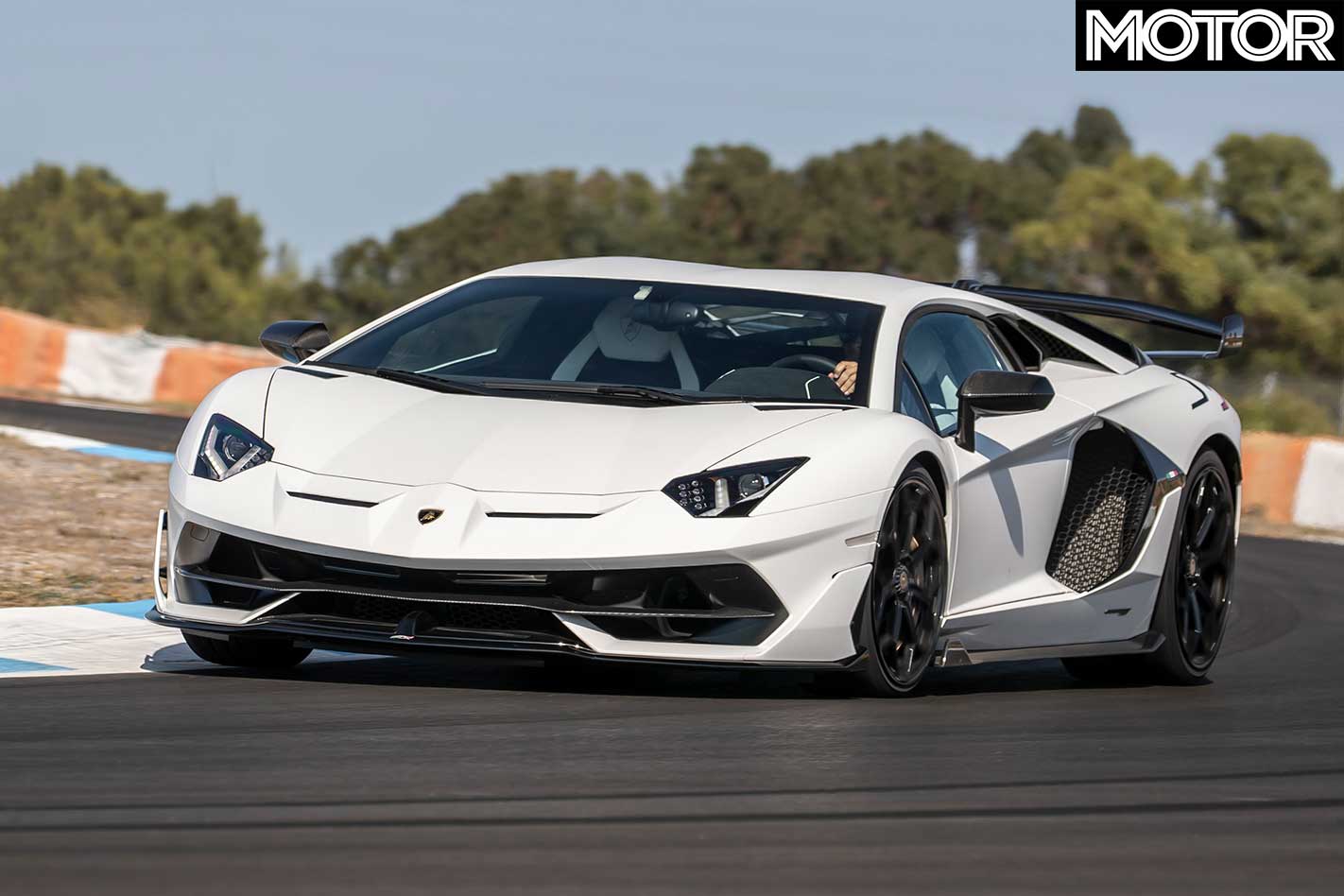
Then there’s the improved aero, which brings the SVJ 40 per cent more downforce than an Aventador S but, significantly, it’s the second-generation of ‘ALA’ (Aerodinamica Lamborghini Attiva 2.0). This means it can push turbulent air out beneath the rear spoiler to stall it, reducing downforce and drag, and which it can split from left to right.
In cornering, then, the SVJ will make more downforce on the inside of the bend, which keeps the body flatter and helps turn-in. Overall lateral g-force isn’t necessarily increased (you’d just put a massive wing on if you wanted to do that), but it apparently means less lock is required to get into a turn.
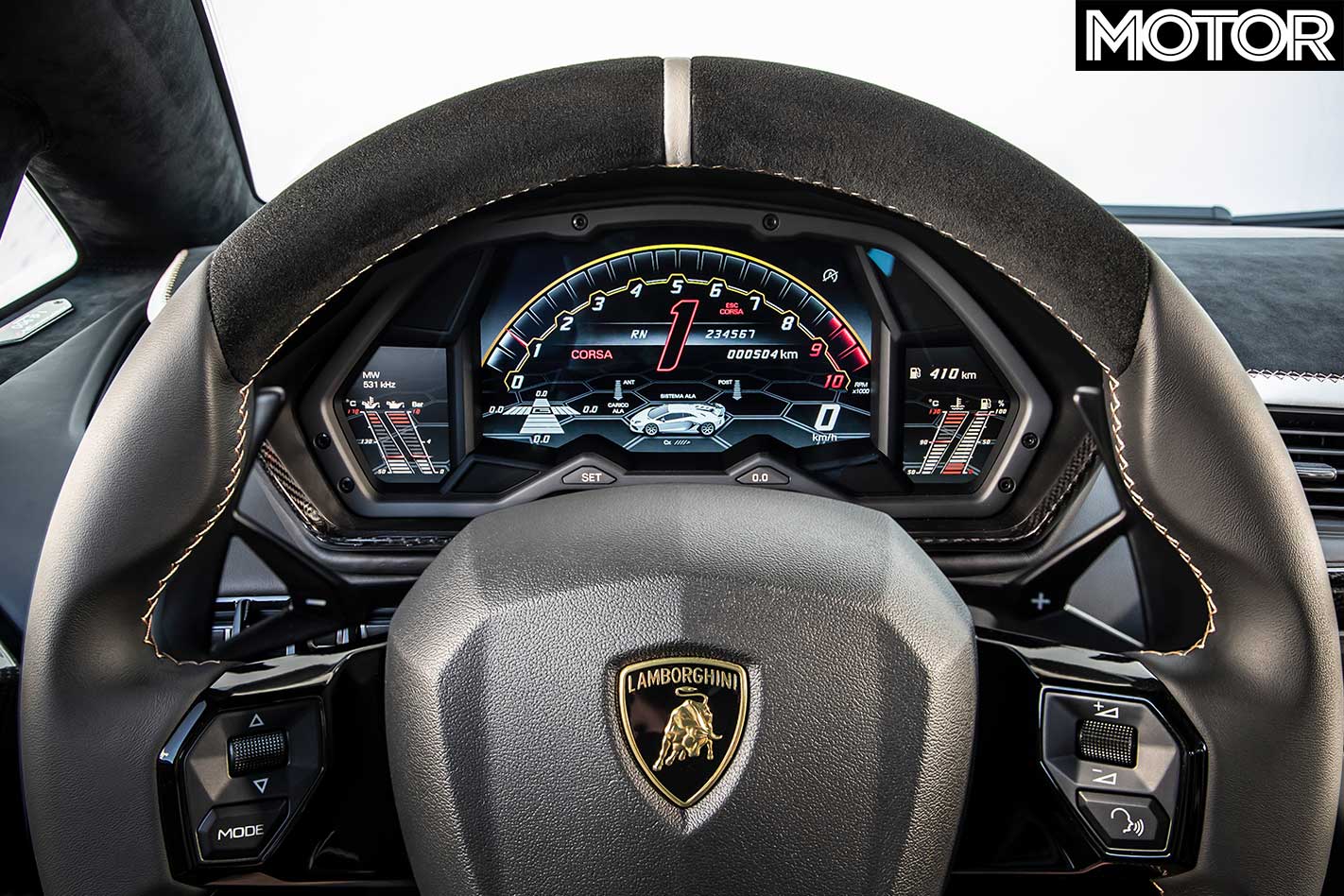
Given there’s less applied lock, more power can be applied, making corner exits even quicker. I don’t think it makes a lot of difference to an overall lap time, but according to one engineer, it could be between one and three seconds around a near seven-minute lap of the Nürburgring.
Making a bigger difference is the option, for the first time, of race-derived Pirelli P Zero Trofeo tyres, rather than Corsas, as on other Aventadors. It’s difficult to determine the exact benefit, but it’s hard to imagine them not cutting at least 10 seconds on a long lap. Plus, the rears are a staggering 355-section units wrapping 13-inch wide rear wheels. That’s an awfully large patch of rubber for a supercar that already benefits from all-wheel drive and 255-section front hoops.
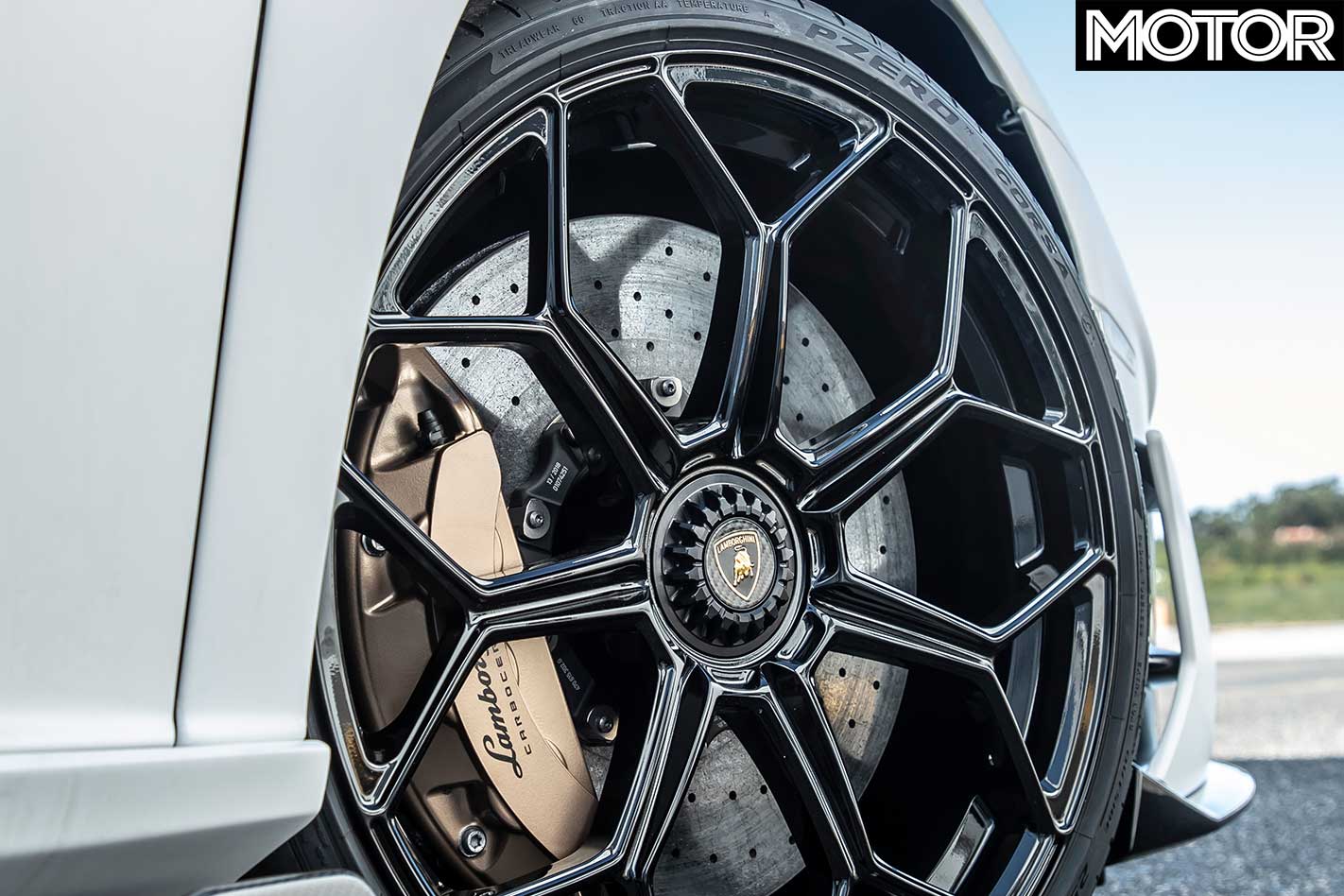
Would it surprise you to learn that the SVJ was extremely fast? Thought not. J is for article J in the old FIA documents that told car makers what they had to do to go sportscar racing. And although the Aventador doesn’t race, there are slower cars that do.
Less focused-feeling ones too. The SVJ is fast in the old-fashioned, brutal way, in a straight line, at least. What might be the world’s greatest production engine is exceptionally urgent, and feels no slower to me than the crop of hypercars I’ve driven. Which, probably, is because it isn’t. Anything that can get to 100km/h in less than 3.0sec isn’t hanging about. Let off the leash, it’ll charge to a 350km/h top speed.
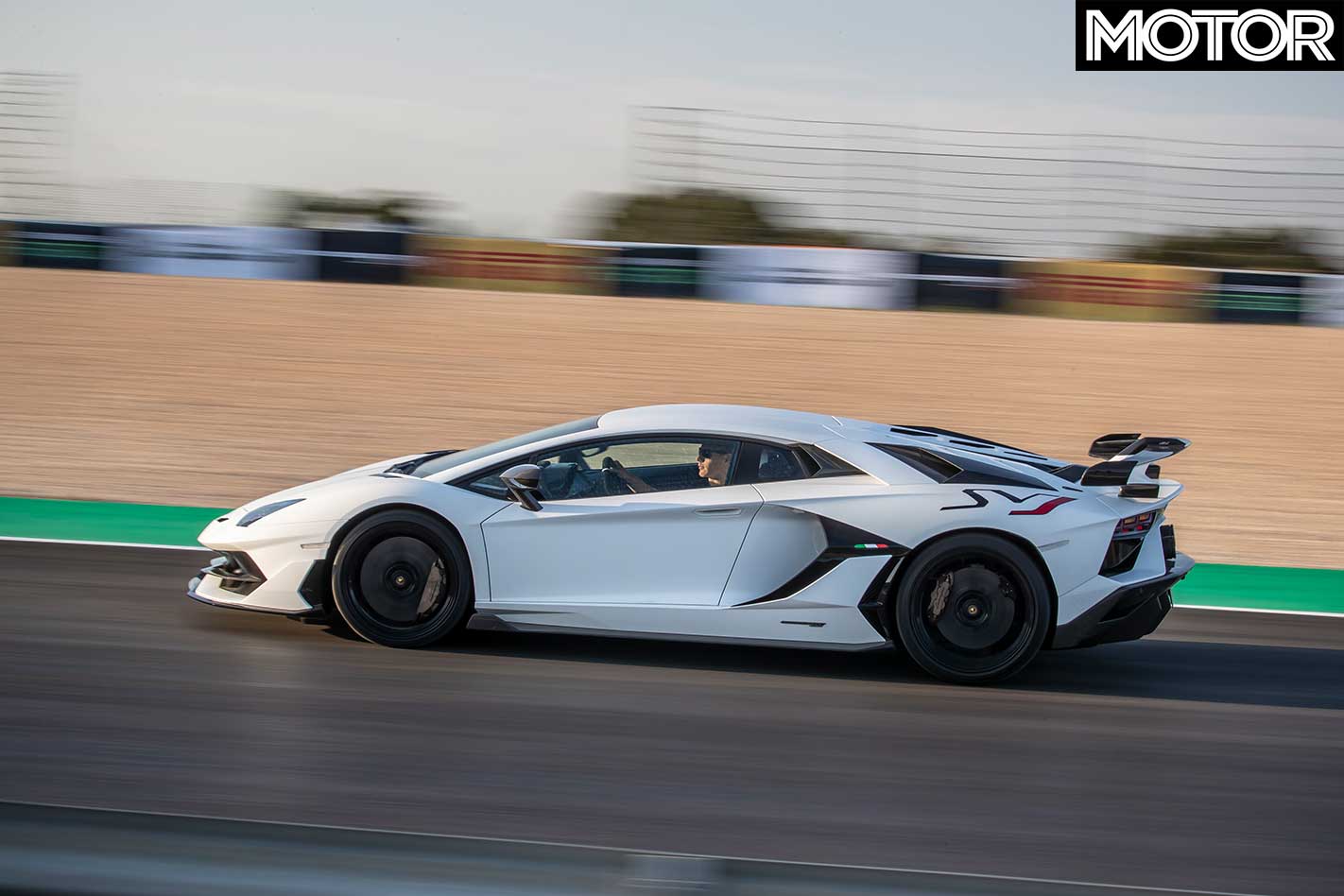
It’s mated to a single-clutch gearbox, which is as terrible most of the time as you’ll expect, fudging through changes with an inordinate amount of head rock. But put the car into ‘Corsa’ mode, which also puts the dynamic steering into a constant rather than variable ratio – so is something you should absolutely do – and it just punches through shifts with a fairly satisfying venom.
Braking is excellent, in terms of strength. You’re aware of the car’s shimmies, though that might be down to the fact that you can feel them well, rather than that they’re more severe than in other cars. Plus there’s the fact that, at the end of Estoril’s main straight, you’re likely doing more than 270km/h. From lower speeds, the SVJ pulls up brilliantly.
What it does from there, though, and into corner entry, can feel odd. It’s natural in a big car to ease off the brakes gently as you begin to turn – it keeps the car’s nose planted and reduces understeer. The rear-steer in the SVJ means you don’t need to do that. In fact, it almost guarantees that you’ll be winding off quite a lot of the lock that you’ve just applied.
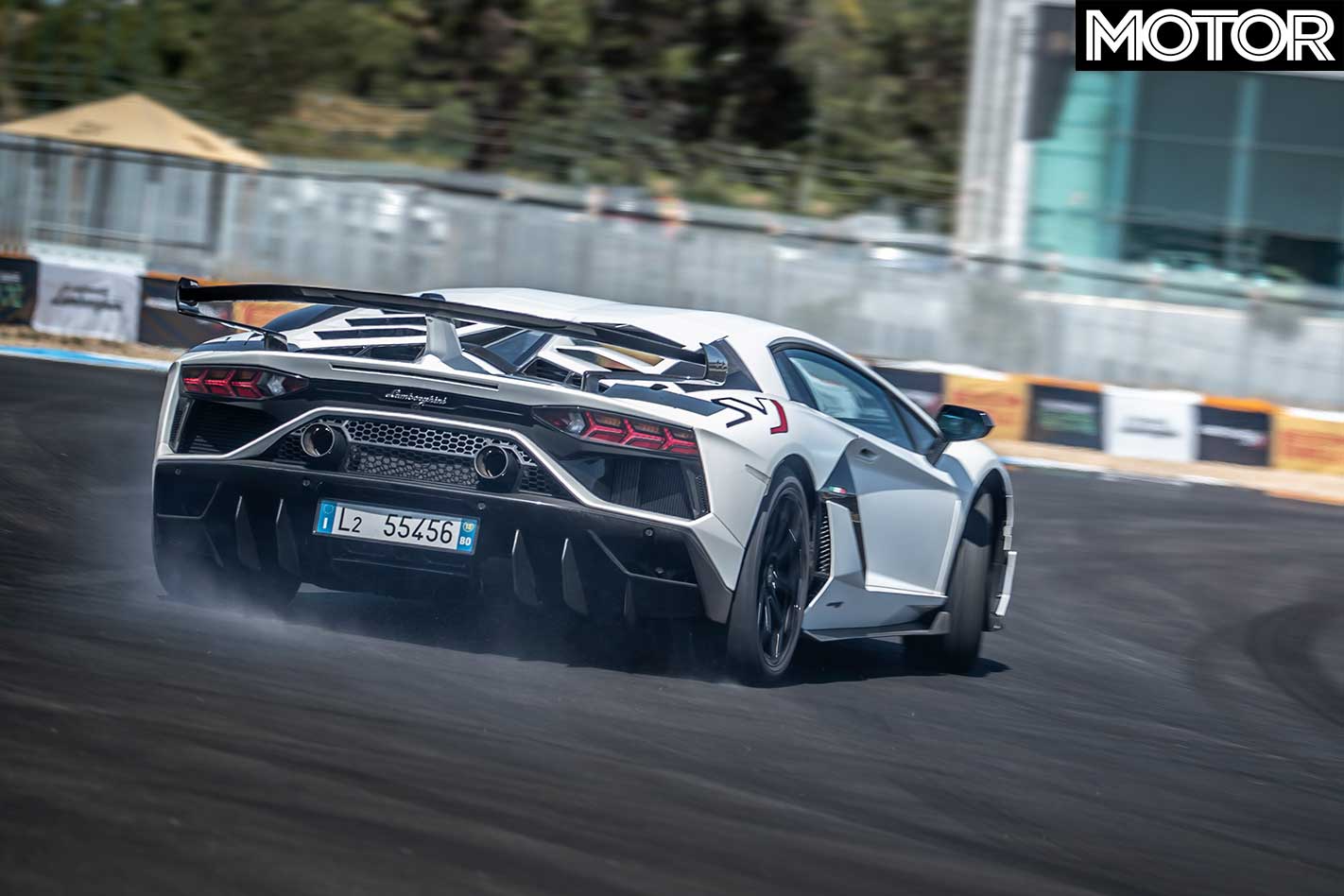
At nearly five metres long, the Aventador is a big car and Lamborghini figures you’ll want all the help you can get to make it feel agile. Job done, then, to that extent. It pays to brake only in a straight line, then turn delicately and let the rear-steer do the work.
That does mean there’s a slight dead spot on the way into a corner, a steady-throttle state before you line up the exit. Although given you’ll be going quite fast, it won’t last that long. And corner exit is, in ‘Corsa’ mode, pretty neutral, but leave the car in ‘Sport’ and it’s slower, and more rear-biased.
However, there’s a small caveat regarding these impressions. Estoril was resurfaced about a fortnight before this was written and therefore about 25 per cent more slippery than usual. Lamborghini says the handling balance would be largely unchanged, unless you tried to give it a ‘bung’ at low speeds, which would induce understeer here.

Our test car ran Corsa tyres too – because Lamborghini didn’t know the low-grip, low-degredation surface was going to be laid when it performed its recce, and brought 240 sets of Corsas for the launch, expecting to get through a day per car. As it is, they still looked new after 20 laps.
On a conventional circuit surface, then, and on Trofeo tyres, the SVJ’s corner speeds would be astonishing, rather than just merely impressive. This is, clearly, in all-round capability as well as straight-line speed, a top-league supercar/hypercar.
Given the interior is laden with carbon fibre, as is the construction – and given the level of aero and handling tech – it’s possibly no surprise that it arrives costing $949,640. Although this looks almost sensibly priced compared with some cars with similar power outputs.
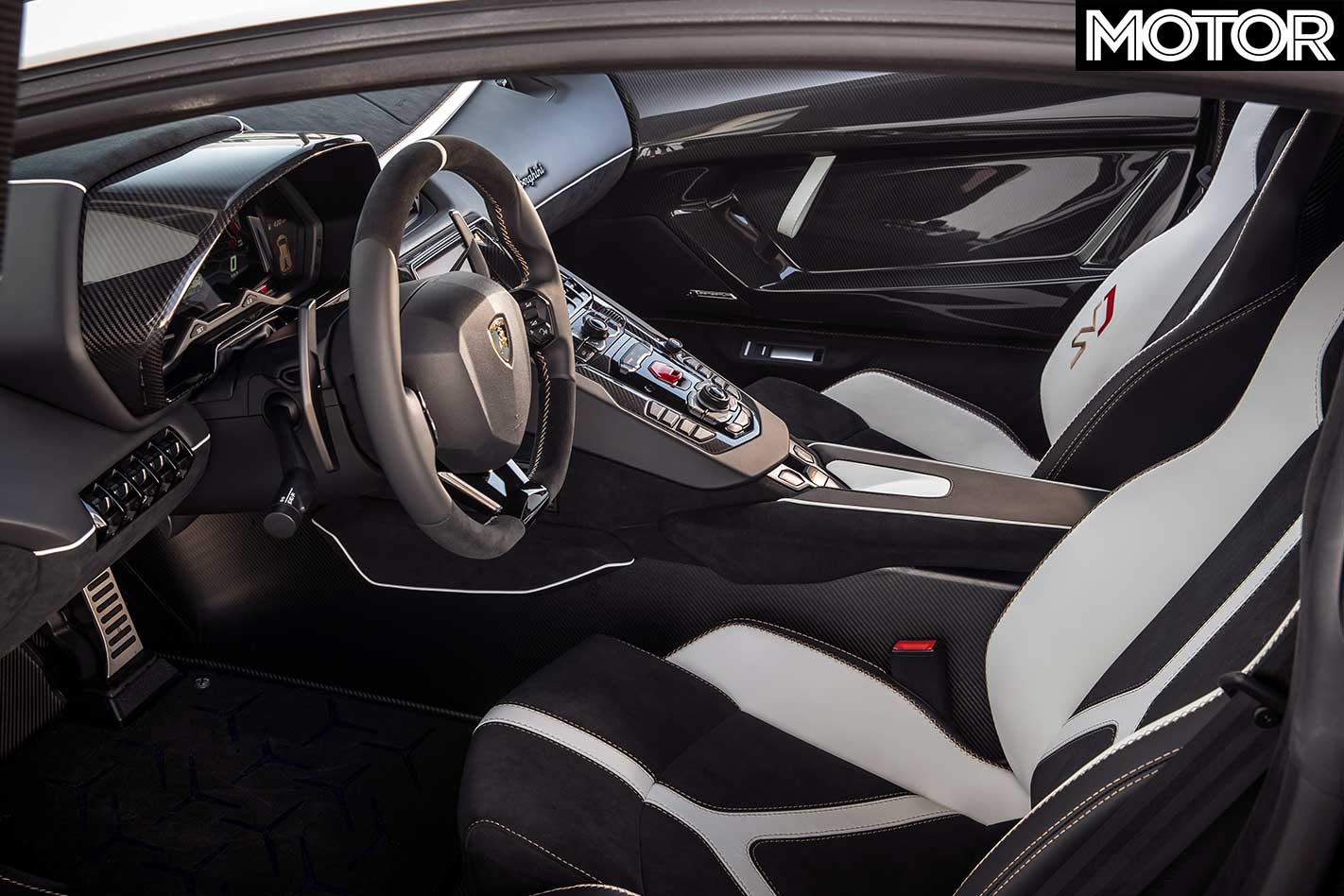
Sure, the interior is, in places, starting to feel its age (the Aventador is now seven years old), the transmission is an antique and the engine doesn’t have any of the fancy hybridisation the market is coming to expect, but the V12’s simplicity is almost worth a premium for that reason alone.
I’d prefer it if getting the best out of the Aventador SVJ’s handling was a bit more conventional, if it gave you more options to drive your way, rather than its way. However, that’s all part of the Pantomime. The SVJ has the ability to frustrate and delight within the same lap. It certainly never leaves you cold or feeling like you’re driving a sanitised version of a once raw experience.
There’s unmistakeable, unfiltered drama at play here. The SVJ needs to be tamed. However, the Aventador now has a dynamic capability that renders it something more than just a show piece – it isn’t a faux halo. The credentials meet the status.
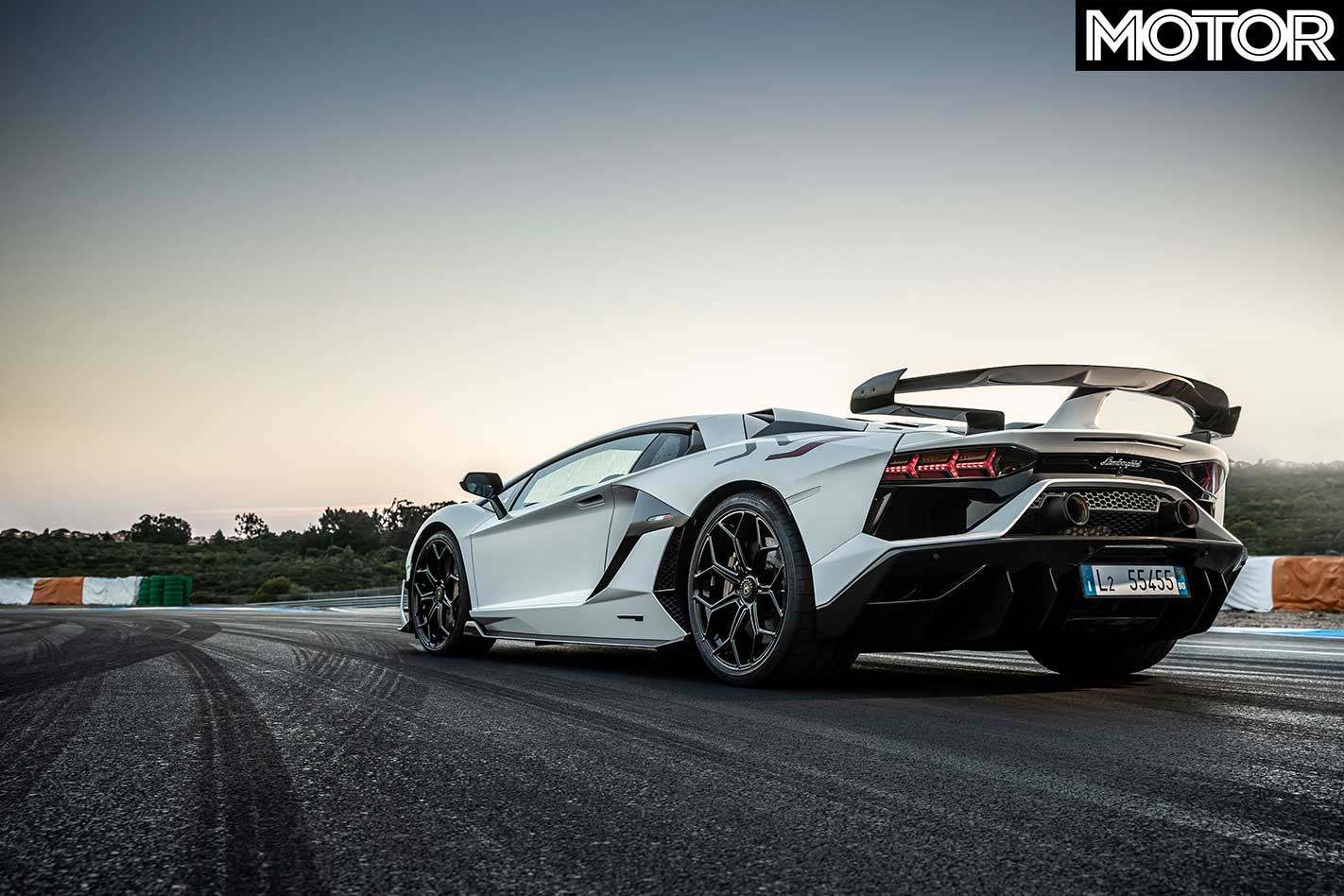
It’s hard not to end where we first started, pondering the fate of the engine that powers such an iconic Lamborghini silhouette. Just 900 SVJs will be made, and although it’s perfectly imperfect in many ways, it has a sound that will stick with you for life – one you simply won’t find anywhere else. And I can’t help but like that.

FAST FACTS 2018 Lamborghini Aventador SVJ
BODY: 2-door, 2-seat coupe DRIVE: all-wheel ENGINE: 6498cc V12, DOHC, 48v BORE/STROKE: 95.0mm x 76.4mm COMPRESSION: 11.8:1 POWER: 566kW @ 8500rpm TORQUE: 720Nm @ 6750rpm WEIGHT: 1525kg POWER-TO-WEIGHT: 371kW/tonne TRANSMISSION: 7-speed single-clutch SUSPENSION: double A-arms, pushrod inboard coilovers, adaptive dampers, anti-roll bar (f/r) L/W/h: 4943/2098/1136mm WHEELBASE: 2700mm TRACKS: 1720/1680mm (f/r) STEERING: electrically assisted rack-and-pinion BRAKES: 400mm carbon cermic discs, 6-piston calipers (f); 380mm carbon ceramic discs, 4-piston calipers (r) WHEELS: 20.0 x 9.0-inch (f), 21.0 x 13.0-inch (r) TYRES: Pirelli P Zero Corsa; 255/30 ZR20 (f), 355/25 ZR21 (r) PRICE: $949,640
PROS: Epic potency; amazing soundtrack; almost everything CONS: Silly price; hard to tame; gearbox; last atmo V12? RATING: 4.5 out of 5 stars
Putting the J in SVJ

J STANDS for Jota, which was a car born from boredom at Lamborghini. In an interview with Hemmings, head test driver Bob Wallace says he had ample time on weekends to play with things around the factory. And in 1970, they were the Miura.
Its flawed performance inspired the SV, which he built upon with aluminium panels, a gutted interior, heavily reworked suspension, new aerodynamics and a dry-sump V12 making 300kW-plus. The single Jota was crashed by a customer, but its legend lived on in the 1971 Miura SVJ – a small run of cars customers requested be built in similar spec to the Jota.

